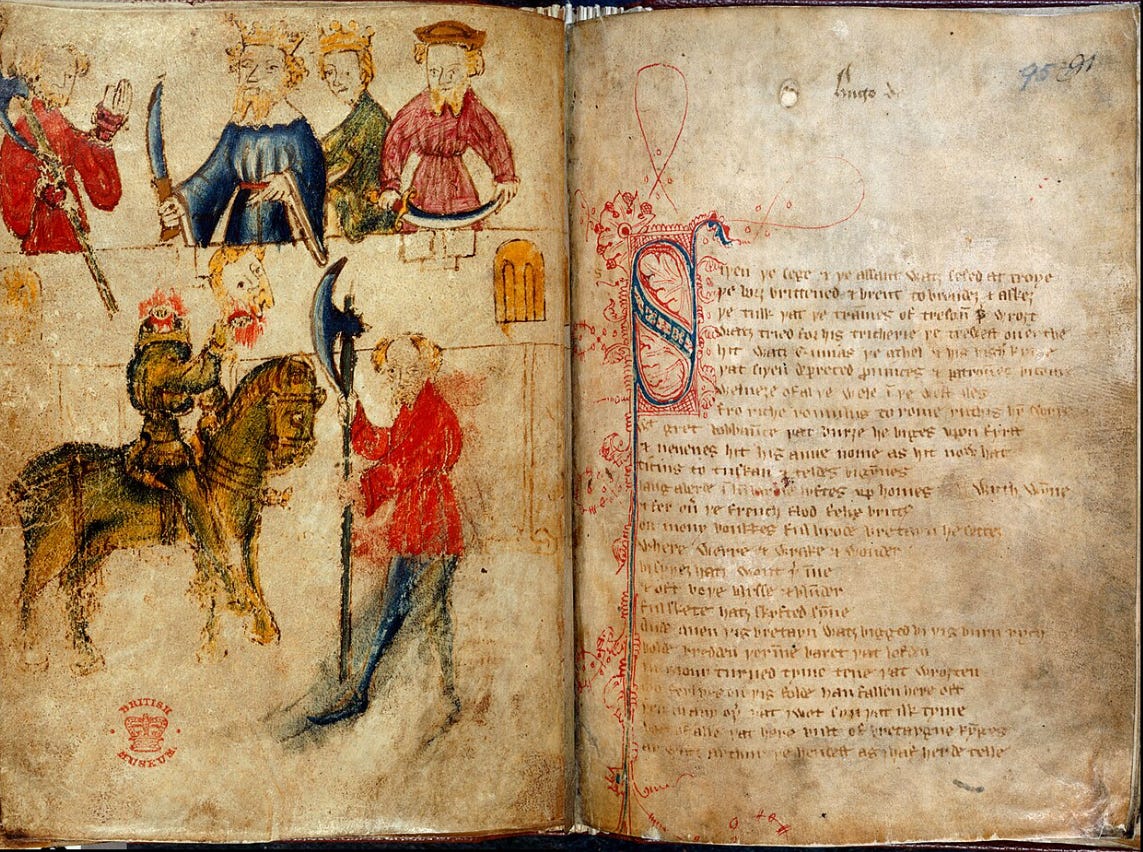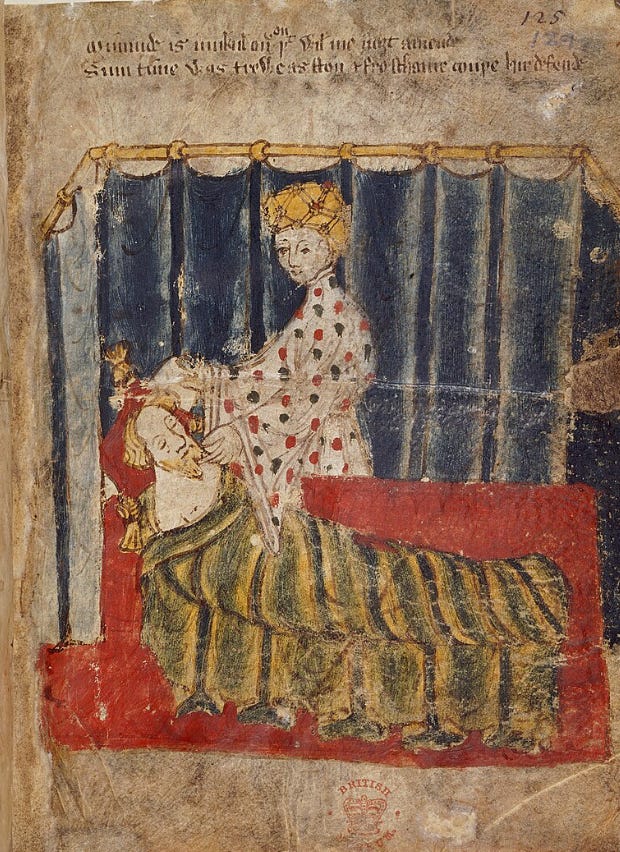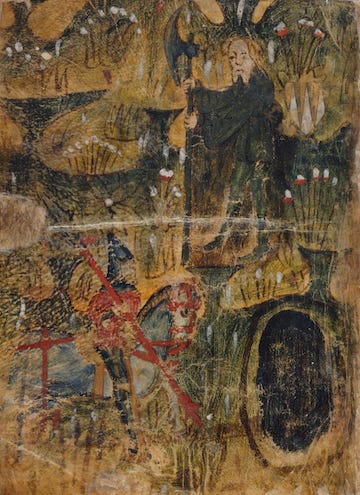Games of Death and Honor
Sir Gawain and the Green Knight, by an unknown poet
Dear Reader,
I have fallen really hard for Sir Gawain and the Green Knight. You know I adore Beowulf for showing me how stories first took shape in Anglo-Saxon times (7th-9th century), but Gawain?! Thoughtly enjoyed it!
Short summary of the poem: A knight accepts a beheading game in King Arthur’s court, and he goes out on a quest which I can almost call a suicide mission (he needs to get a beheading in return), and in the end, discovers that the absolute test is not about strength or courage, but truth. The truth that he believes for himself.
I highly recommend watching this 5-minute summary video of the story before you continue reading my essay. It gives you so much context on what we are going to discuss in a few minutes. There are movie adaptations of this poem, if you want to watch!
I have always been drawn to these ancient texts because they are like windows into past lives, how human life was back then, culturally. And this 14th-century medieval poem did not disappoint me. It was so much fun to read!
The most interesting thing about it is, it touched the most serious themes of human life: honor, mortality, temptation, and the stories we tell ourselves. There were so many symbols throughout the poem that tell us about human vulnerabilities that have not changed much over the centuries.
I am going to tell you about three angles this beautiful text has made me think about.
The Pentangle and the Perfectionism
The Gawain poet (unknown) has introduced the pentangle on Gawain’s shield throughout the poem, even pausing the story to explain it. I could not help but research more into it, because the poet is not just talking about a symbol.

So, the hidden meaning behind it is that a knight at that time, like our Sir Gawain, is meant to embody:
faultless in his senses
flawless in his five fingers
faithful to the five wounds of Christ
mindful of the five joys of Mary
unfailing in the five knightly qualities: generosity, fellowship, chastity, courtesy, and piety
And that is the standard beyond what any man can fully achieve, and the story even tells that perfection is unattainable, but our own truth lies in recognizing our own vulnerability, because we are mortals! To Gawain, a single failure of truth is an absolute failure.
Even when the Green Knight praised Sir Gawain as the noblest knight, and that he is closer to perfection than any other knight. Gawain cannot accept this. And it is not surprising! Did you ever feel the gap between external recognition and inner self-judgement? Because I do! Gawain, at the end does not measure himself by the lowered standards of others, but by the impossible pentangle.
There is also a line in the poem that says,
“How feeble is the flesh, how petty and perverse”
The whole crux of the story that I understood is this → Humans recognize their own mortality, and should learn to accept and wear shame more truthfully than they ever wear pride.
Games, Temptations, and the Testing of Honor
An absurd game, the whole story is about: A Christmas contest. A beheading in exchange for a beheading. But if we look at it from a perspective of why games, we measure competence through challenges and competitions these days. And then, they measured honor through games.
Gawain steps forward, but I had to question if it was willful or bound by duty? He insists that he does it to protect the king, and to spare him from the risk of dishonor.
“Why should I hesitate? Kind or severe, we might engage our fate.”
Sounds more like a submission to necessity rather than heroism.
The theme of the exchanges was so evident throughout the poem. At Sir Bertilak’s castle, the exchange of winnings is similar to the beheading game. Each day, Gawain’s exchanges (the kisses from the lady) are traded for Bertilak’s trophies from his hunt. The third day was interesting, because he hunts a fox (deceit), and Gawain hides the green girdle he gets from the lady.

The lady’s seductions are also framed with the symbolism of Eve and the Fall. The poet brings it out, like in most texts: woman as tempter, and man as vulnerable. In most ancient scriptures, we see that the woman have been cast as the root of man’s downfall. But at the end of this story, Gawain is praised even in his failure. He even calls the lady “madam” at one moment, “lady” at another. “Lady” when acknowledging her socially, and calling her “madam” to put a barrier. It was very subtly put forth by the poet here!
Unlike Adam, who blames Eve, Gawain puts the fall on himself. And that is what I loved about this story, that temptation is inevitable, but honor is in owning our vulnerabilities, rather than displacing them.
The Green Knight and the Green Chapel
Now the Green Knight was the most interesting character in the poem. He is simply death personified. He tells Gawain with such certainty - “You cannot fail to find me”. The poet has marvelously sketched this character because death waits, and it waits for everyone. He also says that no one, from any estate (I have talked a bit more about estates in my Canterbury Tales post, if you want to read) or station in society has ever escaped alive from meeting him.
And the meeting of Sir Gawain and the Green Knight is set on New Year’s Day, which can also resemble a time for both celebration and renewal. It does sound like the cycle of life and death. Inching towards death at the turn of the year, and that is how we measure our mortality too, in calendar years of our own lives.

THE GREEN CHAPEL! Where Gawain was supposed to find the Green Knight, I lived how the poet describes it.
“A place, more likely, where in the dark of midnight the devil says morning prayer”
For Gawain, the world was measured in honor. But what of us now, centuries later? Our battles are subtler (at least I would like to think so), fought in closed doors, communities, and privately.
But I would like to ask the same question though:
By what standards do we measure our humanity now?
Share your thoughts in comments, reply to the email, or drop me a message.
I think, authenticity, compassion, and our integrity are what qualities by which humanity is judged now. Sometimes, resilience too.
We too, are measured now, but we have different scales. Perhaps not by victories in battles, but whether we can hold compassion when it is the hardest and toughest.
When you meet your Green Knight, all Sir Gawain shows us is that we do not need to break, but be more human (however you would like to define humanity).


